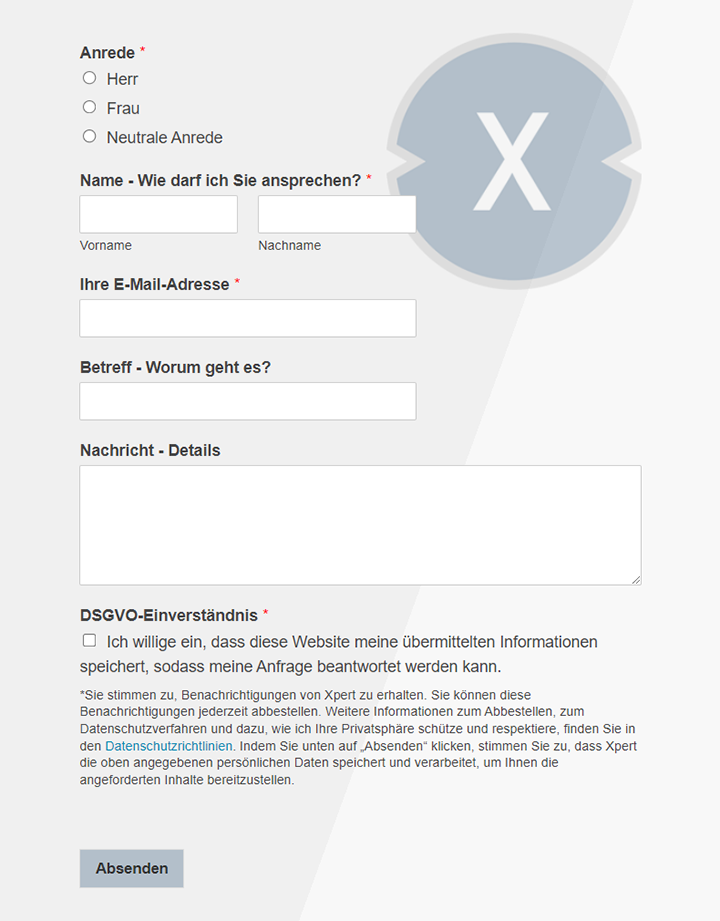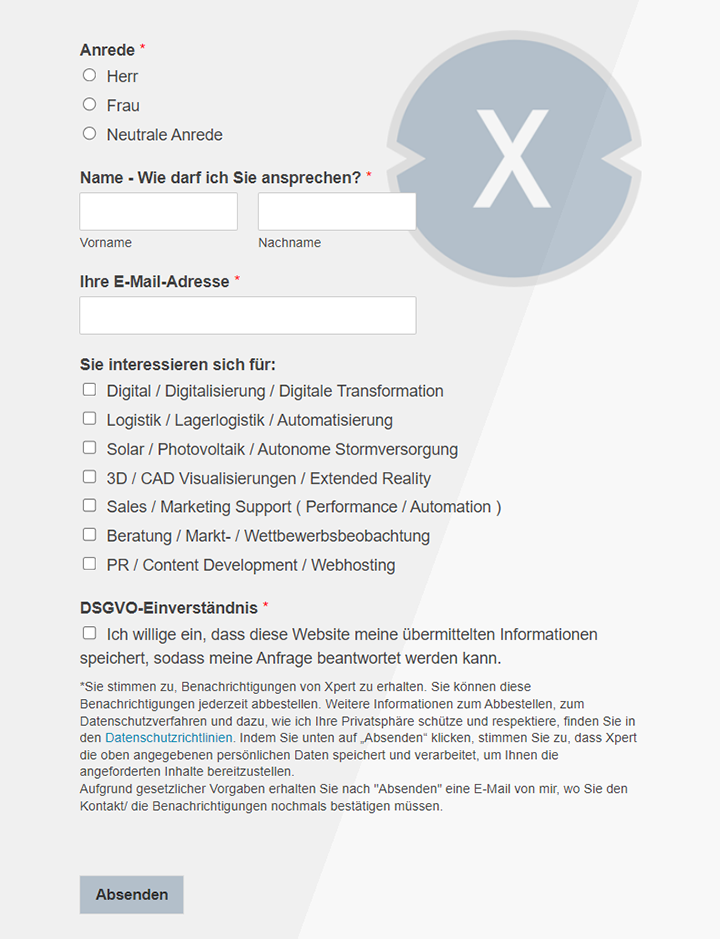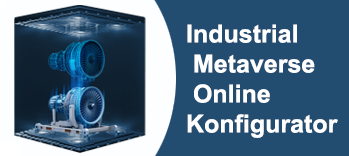The robotic age: an evaluation of the transformation of the global economy and its future development
Xpert pre-release
Language selection 📢
Published on: June 29, 2025 / update from: June 29, 2025 - Author: Konrad Wolfenstein

The robotic age: An evaluation of the transformation of the global economy and its future development - Image: Xpert.digital
Robotics revolutionize the global economy: How intelligent machines shape our future
4.28 million industrial robots worldwide: analysis of a technological revolution
The global economy is at a historical turning point: Robotics have developed from a futuristic vision to a transformative force that redefines the basics of our economic order. This comprehensive assessment illuminates the profound changes that have already caused robotic technologies, and predicts their future development under the influence of artificial intelligence (AI) and geopolitical new facilities. The robotic not only proves to be a technological upgrade, but as a fundamental driver of economic and social transformation.
In order to understand the scope of this development, it is worth taking a look back at the starting point of the global economy around 1970 - a time that was characterized by economic stress through energy crises, inflation and a starting productivity decline. In this challenging context, the robotics established itself as a strategic answer to the existential competitive challenges for Hochlohn countries. A counterfactic view illustrates the immense meaning: a world without robotics would probably be characterized by an almost complete emigration of the manufacturing industry from the west, lower global GDP growth and higher prices for consumer goods.
The quantitative dimension of the robotic revolution is impressive. With an operative existence of over 4.28 million industrial robots in 2023 and an average robot density of 162 units per 10,000 employees in the manufacturing industry, automation has become an integral part of industrial production. Asia, led by China, has established itself as the undisputed center of this development. The robotics have provided a significant productivity dividend, reduced costs and improved the quality. However, these profits were distributed unevenly. Academic studies show that automation for 50 % to 70 % of the increase in walness in the United States is responsible by displacing workers with routine activities and has absolutely reduced wages relatively and partially.
The future of robotics is determined by two main forces: the symbiosis with AI and the geopolitical competition. AI turns robots of preprogrammed machines into learning, adaptive systems, which opens up explosive growth markets in logistics, healthcare, agriculture and collaborative robots (cobots). At the same time, robotics have become a central element of national industrial strategies. There is a strategic divergence between China's state-controlled techno-nationalism ("Made in China 2025") and the research and innovation-driven approach of the USA (National Robotics Initiative) and the EU (Horizont Europa).
The long-term development scenarios range from an "intelligence explosion" with a winner-take-all economy to an adaptation scenario with massive retraining needs to a scenario of stagnation and inequality, if automation remains primarily without significant productivity increases. Which path is taken is not a technological inevitability, but the result of today's political and entrepreneurial decisions.
From this analysis, there are clear strategic imperative: governments have to invest massively in human capital, modernize social security systems and direct innovations in a human cause. Companies have to understand retraining as a core strategy and redesign work processes. After all, the establishment of robust ethical framework conditions for topics such as algorithmic bias, data protection and responsibility is not only a moral necessity, but a strategic factor for building a sustainable and globally competitive robot industry. The era in which robots were considered mere tools is over; We enter into a new phase in which intelligent machines become integral business partners.
Suitable for:
- Europe as a pioneer of automation: In 2024, automobile manufacturers have integrated a total of 23,000 new industrial robots
The redesigned economic landscape: the previous effects of robotics
This part explains the fundamental reasoning by initially defining the economic landscape before robotics, then examining a contradictic world without automation and finally anchored the analysis based on hard data on the actual effects of robotics on productivity and society.
The world before the robot: a Baseline analysis (approx. 1970-1980)
In order to fully grasp the transformative power of robotics, the economic landscape must first be analyzed, which preceded its broad introduction. The 1970s marked a critical turning point where the “Golden Age of Manufacturing” met with considerable headwinds after the Second World War. This era was not characterized by stability, but by considerable economic stress, which created the conditions for the subsequent wave of automation.
The economic framework was shaken by heavy shocks. The 1973 oil crisis led to a quadruple of oil prices from 3 to $ 12 per barrel, which dramatically increased production costs for energy-intensive industries such as steel and automotive industry. At the same time, a high inflation led the central banks to raise interest rates - in the early 1980s to up to 20 % in the USA - which dampened consumption demand and made it more expensive.
During this time, production was a cornerstone of employment in the industrialized countries. In the United States, employment in the processing business in June 1979 reached a historic high with 19.6 million. These jobs were often highly paid for, union organized and formed the foundation of the middle class. However, this model came under pressure. The influence of the unions began to disappear, and the first wave of automation - even before robotics, e.g. B. by computer -controlled machines - was introduced.
At the same time, the US economy experienced a significant slowdown in productivity growth, a significant departure from the post-war boom. The global competition intensified with the rise of newly industrialized countries, in particular the “Asian Tiger” (South Korea, Taiwan, Hong Kong, Singapore), who offered lower labor costs and put the manufacturers in the USA and Europe under enormous pressure. This was the beginning of the great relocation of production to cheaper regions.
Although not yet arrived in the mainstream, the seeds of modern automation were sown. In the 1960s, the first industrial robots for specific, repeated tasks were used. The 1970s produced Computer-Amed Design (CAD) and Computer-Amed Manufacturing (CAM), which began to digitize the design and production process.
The economic crises of the 1970s acted as a strong, albeit painful catalyst for the introduction of automation. The economy before robotics was already under enormous pressure, and the robotic did not enter a stable system, but as a potential solution for a crisis of competitiveness. The manufacturers in the high -wage countries saw themselves exposed to a pliers movement: rising domestic costs (energy, work, capital) and increasing competition from abroad at low costs. Their most important competitive levers were either the relocation of production abroad (globalization) or the drastic reduction in domestic production costs. Early automation and the subsequent robotic revolution offered an efficient instrument for the latter. It was not a technology in search of a problem, but a solution to a existential threat to many production companies. The narrative is therefore not simply “robots destroyed jobs”, but “robots were introduced in an era in which the existing manufacturing model became economically unsustainable, and offered a way to survive for companies in high cost environments”.
A counterfactic economy: global trade without automation
A well -founded thought experiment illustrates the extent of the robotic transformation: What would today's global economy look like if the robot revolution had never taken place? This scenario, which builds on the Baseline of the 1970s, draws the image of a radically different global order.
Without the productivity increases through robotics, the relocation of the production of North America and Europe to low -wage countries would have been far more comprehensive and absolute. It is plausible that entire branches of industry, such as the assembly of automobiles and electronics from the Hochlohn countries, have almost completely disappeared. The currently discussed trend of reshoring would be unthinkable because the difference in wage costs would be insurmountable. Competitiveness would have defined itself almost exclusively through labor costs, which would have massively accelerated the dein industrialization of the West.
The significant contributions of the robotics to productivity and GDP growth-estimates that the annual GDP growth in 17 countries was increased by 0.36 %-would have failed. This would mean a global economy with a growth path less than the past 40 years, which would lead to a lower aggregate prosperity and standard of living.
Global value chains (GVCs) would probably be easier and more fragmented and would be almost exclusively determined by labor cost arbitrations. The complex, just-in-time and highly integrated supply chains based on automated ports, logistics centers and factories would be less realizable. The phenomenon “Made in the World” would be less pronounced. The costs for many industrial goods, from cars to electronics, would be significantly higher due to the dependence on more expensive work or less efficient production methods. The product quality and consistency, a main advantage of robotic precision, would be lower and variable. The era of mass adjustment would be severely restricted.
With regard to the workforce and wages, there could be more low -qualified jobs in manufacturing in high -wage countries, but wages for these jobs would be under extreme downward pressure through global competition. The problem of wage inequality could manifest itself differently - perhaps less than a gap between highly qualified and routinely working workers and more than one abyss between a small class of capital owners and a huge, low -rewarded workers.
In a world without robotics, globalization would probably have previously led to larger geopolitical tensions and protectionism. The ability of the robotic to keep part of the production in the industrialized countries profitably acted as a decisive economic and political security valve. The counterfactic assumption of a massive, accelerated emigration of jobs from the West would have led to even more serious economic faults and social unrest in regions such as the US-Rust-Belt when they were actually experienced. The political pressure to issue high tariffs and protectionist measures in order to "save" these jobs would have been immense and would have probably taken place earlier and more intensively. The robotics that made companies like Ford and GM possible to remain competitive and still produce domestically alleviated the worst effects of this development. It enabled a “productivity compromise” in which companies could reduce labor costs without fully giving up their home countries. Thus, the robotics have not only changed the economy; It subtly re -shaped the political economy of globalization and delayed and changed the counter reaction to it.
The robotic footprint: a global quantitative analysis
Robotics are no longer a niche technology, but a fundamental part of the global industrial basis. A data -based analysis of the current distribution, which mainly relies on the reports of the International Federation of Robotics (IFR), illustrates the extent of this development.
The worldwide operative inventory of industrial robots reached the impressive number of 4.28 million units in 2023, which corresponds to an increase of 10 % compared to the previous year. The annual new installations exceeded the third time in a row of half a million and reached 541,302 units in 2023.
A crucial yardstick for automation intensity is the robot density - the number of robots per 10,000 employees in the processing industry. The global average reached a record of 162 in 2023 and has more than doubled in just seven years (from 74). At the top is the Republic of Korea with 1,012 robots per 10,000 employees, followed by Singapore (770). The rise of China, which has moved to third place with 470 units and has overtaken Germany (429) and Japan (419) with 470 units. The United States is in tenth place with 295 units.
The geographical distribution shows a clear dominance of Asia, which in 2023 70 % of all new installations were lost.
China is the world's largest market by far. The state has an operational inventory of 1.76 million robots (41 % of the global total stock) and was responsible for 51 % of all new installations in 2023. Japan remains a robotic heavyweight with the second largest operational stock (435.299) and a share of 9 % in global installations.
The United States is an important player with 381,964 operational robots and the third highest number of annual installations. Germany is the dominant force in Europe and recorded a record value in 2023 with 28,355 new installations.
The automotive and electronics industry were traditionally the main drivers of adaptation. In 2023, the automotive industry won the top position with 25 % of all installations (135,461 units). The electronics industry fell back to second place with 23 % of the installations (125,804 units), which corresponds to a significant decline of 20 % compared to the previous year and underlines the sector for economic cycles in the consumer goods sector.
Global industrial robot landscape, 2023
Note: KA = no information in the quoted sources for the specific value.
These figures unequivocally show that robotics are an established and growing force in the global economy, the geographical and sectoral distribution of which offers decisive insights into the current and future balance of power in global industry.
The global industrial robot landscape in 2023 shows a clear dominance of China, which has the largest population worldwide with 1,755.132 operational robots and recorded 276,288 new installations, which corresponds to 51 percent of all global installations. Despite these impressive numbers, China's robot density is 470 robots per 10,000 employees. Japan follows with 435,299 operative robots and 46,106 annual installations, which is nine percent of the global share, but with 419 robots per 10,000 employees achieved a similarly high density as China. The United States took third place with 381,964 operational robots and 37,587 new installations (seven percent global), but with 295 robots per 10,000 employees have a lower density. The Republic of Korea is remarkable, which despite the lack of information on the operational inventory of 31,444 new robots (six percent global) and with 1,012 robots per 10,000 employees reached the highest robot density of all countries listed. Germany completes the top 5 with 28,355 installations (five percent global) and a robot density of 429 per 10,000 employees. The global operational inventory comprises a total of 4,281,585 industrial robots at 541,302 annual installations and an average global robot density of 162 per 10,000 employees.
The productivity dividend and its unequal distribution
The introduction of robotics has provided a clear economic dividend, but the distribution of which, however, has significant social challenges. This duality of macroeconomic gain and socio -economic tension is central to understanding the effects of automation.
The undeniable productivity gain is on the one hand. Studies show a clear correlation: An increase in robot density by 1 % correlates with an increase in productivity of 0.8 %. Another analysis estimates that the robotics between 1993 and 2007 contributed 0.36 percentage points to the annual growth of labor productivity. These increases in efficiency are manifested in considerable cost savings through lower labor costs, 24/7 operation and minimized material waste. AI-based robot should reduce production costs by 25 % and improve the quality by 30 %. Intelligent, forward -looking maintenance can reduce downtime by up to 50 %. These effects at the company level add up to macroeconomic growth. A study attributes an increase in annual GDP growth by 0.36 % to the increasing use of robots, and the McKinsey Global Institute predicts that automation will make up up to half of the entire productivity growth that is required for GDP growth of 2.8 % in the next 50 years.
On the other hand, there is the unequal distribution of these profits, which is primarily evident in the polarization of jobs and rewarding. Academic research, in particular the work of Acemoglu and Restrepo, provides a robust explanation framework for this. Automation technologies expand the area of the tasks carried out by capital and displace certain labor groups - especially those that run routine manual and cognitive activities - from the work areas in which they had previously had a comparative advantage.
This displacement effect is not a secondary location. Research documents that between 50 % and 70 % of the changes in the US wage structure in the past four decades have been attributed to the relative wage declines, precisely these labor groups in industries with quick automation. While workers who complement the new technology (e.g. highly qualified analysts, robot technicians) record wage increases, employees whose tasks can be replaced by machines are worse. A study estimates that automation has reduced the real wages of men without a high school degree between 1987 and 2016. This was a main driver for the growing income gap between higher and lower educated workers.
Although automation also creates new jobs (e.g. robot programmer, data analysts, maintenance technicians), the net effect is complex. The report of the World Economic Forum (WEF) of 2023 estimates that 85 million jobs could be replaced by 2025, while 97 million new roles could arise, which indicates a net positive effect, but is associated with massive change and retraining needs. However, the report also notes that the creation of jobs slowed down while the annihilation of jobs accelerates.
This shows a profound shift. The “productivity paradox” of the 1990s, in which massive investments in information and communication technology were not immediately visible in the productivity statistics, seems to be dissolved. However, a “distribution paradox” takes its place. The profits from automation are clearly visible at the corporate and macro level, but they are not distributed broadly, which leads to considerable social and political tensions. The data clearly show productivity and GDP growth through the robotics. At the same time, rigorous academic studies show that the same technological power is the largest individual drivers of wage inequality in the same period. The paradox is that a technology that enlarges the overall economy cake at the same time the shares for a large part of the workforce relatively and sometimes even absolutely reduced. This is a fundamental change compared to earlier technological waves such as electrification, which tended to lead to broad prosperity after an adaptation phase. Acemoglu describes modern automation as a “mediocre technology” because its productivity gains are modest compared to their large negative distribution effects. This knowledge is of crucial importance for political decision -makers: the pure promotion of automation for productivity, without actively controlling its distribution consequences, is a recipe for social instability. The focus must be on the question of whether we automate, shift to the question of how we automate and distribute the profits.
🎯🎯🎯 Benefit from Xpert.Digital's extensive, fivefold expertise in a comprehensive service package | R&D, XR, PR & SEM

AI & XR 3D Rendering Machine: Fivefold expertise from Xpert.Digital in a comprehensive service package, R&D XR, PR & SEM - Image: Xpert.Digital
Xpert.Digital has in-depth knowledge of various industries. This allows us to develop tailor-made strategies that are tailored precisely to the requirements and challenges of your specific market segment. By continually analyzing market trends and following industry developments, we can act with foresight and offer innovative solutions. Through the combination of experience and knowledge, we generate added value and give our customers a decisive competitive advantage.
More about it here:
Automation 2030: Three scenarios for the human-machine economy of the future
The next wave: AI, geopolitics and the future of automation
This part shifts the focus from a historical assessment on a forward -looking analysis and examines the three mighty forces that will define the next chapter of robotics: the merger with AI, the escalating geopolitical competition and the long -term redefinition of human work.
Suitable for:
- Automation and robotics as a key driver in modern logistics: Hwarobotics, Iggy Rob, Robotize and Roeq
The intelligence catalyst: How AI redefined the robotics
The next evolution of robotics is promoted by the profound integration of artificial intelligence (AI). This symbiosis transforms robots of preprogrammed machines that perform repetitive tasks in structured environments into adaptive, capable of learning that can act in complex and unstructured real world. AI delivers the “brain” for the “body” of the robot and is the primary technological driver for future growth.
The decisive AI technologies that enable this transformation are:
- Computer Vision: enables robots to visually record and interpret your surroundings, which is essential for navigation, object recognition and interaction.
- Machine learning (ML) & reinforcing learning: enables robots, learning from data and experiences and to improve your performance in tasks such as grasping objects or navigating in complex ways without the need for explicit programming.
- Processing of natural language (NLP): enables a more intuitive human-robot interaction through voice commands.
- Predictive analysis: allows robots to predict problems such as maintenance needs, which prevents downtime and increases efficiency.
This AI-controlled evolution opens up transformative growth in sectors that go far beyond the traditional factory hall:
- Logistics & warehousing: The e-commerce boom and the efficiency pressure fuel a huge market for logistics robots (autonomous mobile robot, driverless transport systems). The market is expected to grow from $ 14.5 billion in 2024 to approximately $ 35 billion in 2030 (CAGR approx. 16 %). Companies like Amazon already use 750,000 robots to automate their fulfillment centers.
- Healthcare: a rapidly growing area. The market for medical robotics is expected to increase from USD 16.6 billion to $ 63.8 billion in 2032 in 2023. The applications include high-precision robot-based surgery (e.g. the da Vinci system), patient care, disinfection and medication.
- Agriculture (Agri-Tech): Driven by a shortage of labor and the need for nutritional security, the market for agricultural robots faces a massive expansion. Forecasts assume growth of approximately $ 15-18 billion in 2024/2025 to over 90 billion to 2034 (CAGR approx. 20-25 %). Robots are used for precise plants, weeds, sprays and harvests.
- Collaborative robots (Cobots): This is a decisive emerging market. Cobots are designed in such a way that they work safely alongside people are more cost -effective and easier to program, which makes them ideal for small and medium -sized companies (SMEs). The market is expected to grow from $ 2.1 billion in 2024 to over $ 11.6 billion in 2030 (CAGR> 31 %). You will find quick distribution in assembly, welding and in the material handling.
Growth forecast for important aspiring robotic segments
Note: CAGR and market forecasts vary depending on the source and forecast period.
These figures show that the future of robotics is not only in more factory robots, but also in diversification in completely new, growing -strong economic sectors, all of which are driven by AI. This quantifies the “next wave” of automation.
The robotics industry shows extraordinary growth perspectives in various segments. In the area of logistics and warehousing, the market of $ 14.5 billion will grow to USD 35.0 billion by 2030 in 2024, which corresponds to an annual growth rate of 15.9 percent. The driver of this development are the ongoing e-commerce growth, the need for increases in efficiency and the increasing shortage of labor.
Healthcare and medicine also have impressive figures: from USD 16.6 billion in 2023, the market is expected to increase to $ 63.8 billion by 2032. Precision surgery, demographic change and lack of personnel act as the main driver of this expansion.
The agricultural sector is particularly dynamic, where robotic solutions between $ 14.7 and $ 18.2 billion include $ 2024/25 and are to grow to $ 92.4 billion by 2034. With a forecast annual growth rate of 19.7 to 25.2 percent, this development is promoted by nutritional security, labor shortages and increasing precision agriculture.
Collaborative robots, so -called cobots, which will increase from USD 2.1 billion to $ 11.6 billion by 2030 in 2024 show the strongest growth thrust. With an extraordinary annual growth rate of 31.6 percent, this segment benefits from flexibility for small and medium-sized companies, increased security standards and the progressive human-robot collaboration.
The new industrial race: geopolitical strategy and technological dominance
Robotics and AI have developed from purely economic tools to central pillars of national geopolitical strategies. The way the global powers promote these technologies reveals profound differences in their economic and political philosophies.
China's “Made in China 2025” (MIC 2025) is a state-controlled industrial policy with the aim of making China a dominant force in global high-tech production, including robotics and AI. The explicit goal is to reduce the dependence on foreign technology and to achieve 70 percent self -sufficiency with core components and materials by 2025. This represents a direct challenge for the technological management of the West. The strategy uses massive state subsidies that are valued on hundreds of billions of dollars, the mobilization of state -owned companies, interest -bearing companies and one aggressive procurement of foreign intellectual property and talents. The results are visible: China's robot density increases rapidly, and its domestic robot manufacturers now conquer 47 % of their home market, compared to a long -term average of 28 %.
The United States National Robotics Initiative (NRI) pursues a more decentralized, research-oriented approach to accelerate the development and use of robots that work cooperatively with people (Co-Robots). The goal is to promote basic research and maintain the innovation leadership of the United States. The NRI is a multi-agency federal program (NSF, NASA, NIH, USDA etc.), which provides funds for academic and non-profit research. The financing amounts to dozens of dollars per year per agency and focuses on areas such as human-robot interaction, scalability and social effects. This is in a sharp contrast to China's top-down approach in the industrial structure.
The strategy of the European Union (Horizont Europa) aims to strengthen the scientific and technological basis of the EU, increase innovation capacity and maintain competitiveness while ethical aspects are preserved. The EU considers robotics to be essential for re -industrialization and coping with social challenges such as an aging population. The EU uses its massive F & e-framework program Horizont Europa (EUR 95.5 billion budget until 2027) to finance research projects. It maintains a public-private partnership (Sparc) to coordinate the efforts and is planning a comprehensive EU-wide robotics strategy for 2025. The focus is on building a strong ecosystem and a regulatory framework (e.g. the AI law).
These different approaches also manifest themselves in the debate about the new configuration of supply chains (Reshoring/Nearhoring). Geopolitical tensions and supply chain interruptions have caused Western companies to consider relocating production home. Automation is considered the key factor for this change because it can compensate for the higher labor costs in the USA and Europe. Surveys show a strong intention: 74 % of European and 70 % of the US companies are planning a re- or nearshoring, whereby the majority are planning to invest in robotics to enable this. However, reality is more complex. A study by the World Bank found a negative relationship between the introduction of automation and reshoring from 2008-2019, which indicates that automation may have made offshore production even more efficient and attractive, thus reducing the incentive to reshoring.
There is a fundamental philosophical and strategic divergence in the approach of the great powers to the robotics. China pursues a state capitalist model of “techno-nationalism” that aims at industrial dominance and self-sufficiency. The United States and the EU pursue a more “liberal-technological” model that focuses on basic research, public-private partnerships and regulatory leadership. This is not just a technology competition, but also a meeting of economic systems. China MIC 2025 explicitly sets the targets of import substitution and the creation of national champions to master the world markets. The US NRI and the European Horizon Europe, on the other hand, focus on the financing of “basic research” and the “protection of ethical aspects”. This reflects its underlying business philosophies: China's state -directed development compared to the market -oriented innovation ecosystem of the West. This prepares the stage for a long -term competition battle, which is held on different battlefields.
At the same time, the reshoring narrative is too simplified. Automation is a double -edged sword for supply chains: it can enable reshoring by making domestic production profitably, but it can also solidify offhoring by making distant factories even more efficient and inexpensive. The final result will depend on a complex interplay of technology costs, labor costs, transport costs and geopolitical risk bills. The current reshoring trend could therefore be more of non-economic factors (geopolitical risk, state incentives) than driven by the pure economic invoice of automation. Automation is a necessary but not a sufficient condition for reshoring.
Long-term scenarios for human-machine economy
The synthesis of the current trends enables the prognosis of potential long -term future future for the global economy, which go beyond short -term projections and take into account profound structural changes. Three main scenarios crystallize, each of which is based on different assumptions about the development of technology and society.
- Scenario 1: The intelligence explosion & the Winner-Take all-farm
This scenario popular in Silicon Valley assumes that the application of AI on AI development itself will lead to recursive self-improvement and an exponential increase in technological skills. In combination with the robotics (“self -driving laboratories”), this could lead to unprecedented progress in all areas, from medicine to materials science. The economic result is an “Winner-Take-All” dynamics in which the company or the nation, which first achieves this breakthrough, accumulates an immense economic and political power. This could exacerbate inequality at a global level, but also potentially create an economy of abundance according to the scarcity. - Scenario 2: The transformation and adaptation management
This is a more moderate scenario that matches the forecasts of OECD and WEF. It postulates that AI is an all -purpose technology (General Purpose Technology, GPT), such as the steam power or electricity, which will redesign all sectors profoundly, but does not lead to mass unemployment. The cereal dynamics are a continuous change on the labor market: tasks are automated, jobs are transformed and new jobs are created. The WEF predicts that 14 % of today's jobs will be new jobs by 2030 (170 million), while 39 % of the core competencies of an employee will be out of date. The central challenge in this scenario is not a lack of jobs, but a massive qualification gap and the need for “lifelong learning” to keep up. - Scenario 3: The stagnation and inequality economy
of this scenario builds on the work of Acemoglu and Restrepo. It suggests that if future automation remains “mediocre”-that is, work displaced without creating massive productivity increases-the result could be a continued slow GDP growth with increasing inequality at the same time. In this future, automation primarily serves to shift income from work to the capital owners, which travels the middle class and dampens the demand for consumption. This could lead to a self -reinforcing cycle in which a weak demand discourages the investments that would be necessary for groundbreaking innovations, which leads to economic stagnation.
Regardless of the scenario, AI and robotics will have profound effects on state budgets. A broad use could increase GDP and tax revenue. However, the displacement of jobs could increase expenses for social security systems (unemployment, retraining programs). The use of AI by the government itself could increase efficiency (e.g. in tax collection), but also requires considerable preliminary investments.
The final long -term economic result is not technologically predetermined. It is shaped by the political decisions that are now made in the areas of education, F&-funding, taxation and social support. The three scenarios are all plausible and are based on different interpretations of the existing data. Scenario 1 depends on a certain technological breakthrough. Scenario 3 depends on the continuation of a certain type of automation (working, but not highly productive). Scenario 2 is the middle ground. Politicians can influence which path we take. For example, a tax policy that favors capital against work can promote “mediocre” automation and urge us towards scenario 3. Conversely, massive public investments in basic research and education could promote more complementary technologies and a highly qualified workforce and steer us towards scenario 2. So the “future of work” is not something that will simply happen to us; It will be actively designed by the political and investment decisions of governments and companies in the coming decade. The debate about the future is actually a debate about the priorities of the present.
Our recommendation: 🌍 Limitless reach 🔗 Networked 🌐 Multilingual 💪 Strong sales: 💡 Authentic with strategy 🚀 Innovation meets 🧠 Intuition
At a time when a company's digital presence determines its success, the challenge is how to make this presence authentic, individual and far-reaching. Xpert.Digital offers an innovative solution that positions itself as an intersection between an industry hub, a blog and a brand ambassador. It combines the advantages of communication and sales channels in a single platform and enables publication in 18 different languages. The cooperation with partner portals and the possibility of publishing articles on Google News and a press distribution list with around 8,000 journalists and readers maximize the reach and visibility of the content. This represents an essential factor in external sales & marketing (SMarketing).
More about it here:
The end of automation: Why robots become real business partners
Navigation in the robotic age: strategic recommendations and ethical framework conditions
This last part translates the analysis into implementable strategies and illuminates the crucial ethical guardrails that are necessary to ensure that the robotic age benefits the entire society.
Suitable for:
A political timetable for an automated future
This section summarizes the challenges identified in the entire report into a coherent sentence of political recommendations for the most important interest groups.
For governments
- Investment in human capital: by far the most important challenge is to improve the width and quality of education and training. This includes strengthening the MINT skills, but also the concentration on competencies that machines cannot easily reproduce: creativity, critical thinking, cooperation and resilience. “Lifelong learning” should be supported by subsidized accounts or tax incentives for retraining.
- Modernization of the social security systems: The old model of unemployment insurance is unsuitable for an era of constant job change. New ideas such as wage insurance (to increase wages for repressed workers who accept poorly paid jobs), more generous wage tax credits and transferable services for employees in the GIG-ECONTER must be researched and tested.
- Control of the innovation: Tax policy and F&E funding should be used to promote the development of technologies that complement human work and not just replace. It should be considered to tax companies that permanently relieve employees due to automation, while those who retrain them are subsidized.
For companies
- Retraining as a core strategy: Company leaders predominantly expect you to retrain your workforce. This must not be a subsequent thought, but must become a central component of the corporate strategy. Investments in training in the workplace and partnerships with educational institutions are essential.
- Redesign of work and work processes: The integration of people and machines must be actively designed in order to create safe, productive and fulfilling work environments. The focus should be on human-machine collaboration, which can be more productive than humans or robots alone.
For educational institutions
- Curriculum reform: The curricula must be updated in order to prepare the students for the future of work. This means less memorizing and more emphasis on problem solving, system thinking and digital competence.
- Integration of robotics into education: there is a significant gap between the importance of robotics and its presence in the educational programs. More institutions have to use robots in class to build up a sustainable workforce.
The ethical imperative: the government of a world of intelligent machines
This section deals with the decisive non-economic challenges that, if they are not mastered, undermine public trust and hinder progress.
- Prefabricity and fairness: AI systems learn from data, and if this data reflects historical prejudices, the robot discrimination they controlled will maintain and even increase and even increase. This requires the development of diverse and representative training data records and the implementation of regular algorithmic audits.
- Data protection and monitoring: Robots equipped with cameras, microphones and sensors are powerful data acquisition devices. Their use in apartments, hospitals and public spaces raises considerable data protection concerns. Clear regulations are required to regulate data collection, use and storage to ensure transparency and user control.
- Responsibility and liability: With increasing autonomy of robots, the determination of responsibility becomes complex in the event of damage. If a self -driving car has an accident or an operation robot makes a mistake, who is liable - the owner, the manufacturer, the programmer? Clear legal framework conditions are essential to clarify these questions. This is particularly urgent with fatal autonomous weapons where international agreements are required.
- Human robot interaction and social effects: The increasing integration of robots into everyday life, especially social or accompanying robots, raises psychological and social questions. There are concerns about emotional dependency, the potential that robot human relationships rather replace than complement, and how this could change our feeling for empathy and community. Ethical design must put human well -being and social connection in the foreground.
The ethical challenges of robotics and AI are not separated from the economic and geopolitical questions, but are deeply intertwined with them. An failure to establish an ethical governance can become a significant economic and competitive disadvantage. The EU's approach is significant for this. She explicitly couples her technology funding (HORIZONT Europe) to strong regulatory and ethical framework (the AI law). This can be seen as a strategic move. By establishing a “gold standard” for trustworthy and ethical KI/robotics, it could use this as a competitive advantage, similar to how it did with data protection (GDPR). Companies and countries that are perceived as ethically negligent could be confronted with a “trust deficit” that leads to consumer reactions, limited market access in regulated regions such as the EU and difficulties in the recruitment of top forces. A proactive ethical governance is therefore not just a question of “right action”, but a decisive part of a long -term strategy for building a sustainable and globally competitive robotic industry. It transforms a potential burden into a strategic advantage.
From automated tools to business partners
The analysis has shown that the robotics have already irrevocably changed the global economy and its transformative strength, driven by convergence with artificial intelligence and shaped by geopolitical imperative, is further increasing. The era in which robots were considered simple, repetitive tools for increasing efficiency is definitely over. We enter into a new phase in which intelligent, autonomous machines become integral actors in the economy - partners, competitors and catalysts of change.
The journey from the first programmable arms in the factories of the 1970s to the AI-controlled systems of today was a reaction to economic pressure and a source of immense productivity gains. Without this development, the industrial map of the West today would be karger, the global supply chains are less sophisticated and many consumer goods would be more expensive. But this dividend had its price: a significant increase in wage inequality and a painful displacement of workers whose skills have been replaced by machines.
The future promises even deeper integration. The next wave of robotics will not only penetrate factories, but also hospitals, farms, warehouses and our households. This exponential growth potential has put the robotics at the center of national strategies and sparked a global race for technological dominance that will have a say in the contours of the world order of the 21st century.
However, long -term development is not predetermined. The scenarios range from a future of technological abundance to a future of stagnation and social division. The decisive factor that will be the decisive factor is not the technology itself, but our ability to control it manner. Our future prosperity depends on whether we can make this new, complex partnership with intelligent machines wisely, fairly and ethically. This requires courageous investments in education and lifelong learning, the modernization of our social security systems and the creation of robust ethical and legal framework conditions. This is the only way to ensure that the advantages of the robotic age are shared broadly and create a future, serves in the technology of all of humanity.
We are there for you - advice - planning - implementation - project management
☑️ SME support in strategy, consulting, planning and implementation
☑️ Creation or realignment of the digital strategy and digitalization
☑️ Expansion and optimization of international sales processes
☑️ Global & Digital B2B trading platforms
☑️ Pioneer Business Development
I would be happy to serve as your personal advisor.
You can contact me by filling out the contact form below or simply call me on +49 89 89 674 804 (Munich) .
I'm looking forward to our joint project.
Xpert.Digital - Konrad Wolfenstein
Xpert.Digital is a hub for industry with a focus on digitalization, mechanical engineering, logistics/intralogistics and photovoltaics.
With our 360° business development solution, we support well-known companies from new business to after sales.
Market intelligence, smarketing, marketing automation, content development, PR, mail campaigns, personalized social media and lead nurturing are part of our digital tools.
You can find out more at: www.xpert.digital - www.xpert.solar - www.xpert.plus































